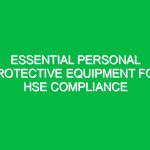Introduction to ISO 45001
ISO 45001 is the international standard for Occupational Health and Safety (OHS) management systems. It was published by the International Organization for Standardization (ISO) and aims to provide a framework for organizations to improve employee safety, reduce workplace risks, and create better, safer working conditions. The standard is a response to the growing need for organizations to proactively manage OHS and ensure compliance with legal requirements while fostering a culture of safety.
In today’s world, where workplace safety is more critical than ever, ISO 45001 serves as a roadmap for organizations across various sectors. It helps organizations not only safeguard their employees but also boost productivity and enhance their reputation. As companies increasingly understand the importance of a robust OHS management system, ISO 45001 stands out as a beacon for those committed to achieving excellence in health and safety.
Understanding Hazards and Risks in the Context of ISO 45001
One of the core tenets of ISO 45001 is the identification and management of hazards and risks. But what exactly does that entail?
Defining Hazards and Risks
A hazard is anything that has the potential to cause harm, while a risk is the likelihood that a hazard will cause that harm. For example, in a manufacturing environment, a machine may be a hazard if it has exposed moving parts. The risk is determined by evaluating how likely it is that an employee could get injured while operating that machine.
Common Hazards Associated with ISO 45001
Several hazards can impact workplace safety. Here are a few notable examples:
1. **Physical Hazards**: These include machinery, tools, and equipment that can cause injury through cuts, crushing, or other physical impacts. An employee working near heavy machinery without proper safeguards is exposed to significant physical risk.
2. **Chemical Hazards**: Exposure to harmful substances like solvents, acids, or gases can lead to serious health issues. For instance, workers in a chemical plant must handle various substances that require stringent safety measures.
3. **Biological Hazards**: This category involves exposure to bacteria, viruses, or other biological agents. Health care professionals, for example, must be vigilant about protecting themselves from infectious diseases.
4. **Ergonomic Hazards**: Poor workplace design can lead to musculoskeletal disorders. Office workers often suffer from repetitive strain injuries due to improper desk setups.
5. **Psychosocial Hazards**: Factors like workplace stress, harassment, and violence can severely impact employee mental health. Not addressing these risks can lead to high employee turnover and low morale.
Safety Precautions and Best Practices for ISO 45001
Implementing ISO 45001 is not merely about compliance; it’s about fostering a culture of safety. Here are some actionable safety precautions and best practices:
1. Conduct Regular Risk Assessments
Regular risk assessments are essential to identify new hazards and evaluate existing risks. Organizations should engage employees from various levels in this process, ensuring a comprehensive understanding of the workplace dynamics.
2. Develop a Clear Health and Safety Policy
An OHS policy that outlines the organization’s commitment to health and safety is vital. This policy should be communicated to all employees and should include objectives, responsibilities, and procedures for reporting hazards.
3. Training and Awareness Programs
Investing in training ensures that employees are aware of potential hazards and know how to mitigate risks. For instance, regular safety drills and workshops on emergency procedures can prepare employees to act swiftly in a crisis.
4. Use Personal Protective Equipment (PPE)
PPE is critical in minimizing exposure to hazards. Ensure that employees have access to and are trained in the proper use of PPE, whether it’s helmets, goggles, masks, or gloves.
5. Foster Open Communication
Encourage employees to voice their concerns and report hazards without fear of retribution. An open-door policy can help cultivate a culture of safety where everyone contributes to maintaining a safe work environment.
Regulations and Standards Governing ISO 45001
ISO 45001 is not standalone; it complements various regulations and standards that govern workplace health and safety. Key regulations include:
1. Occupational Safety and Health Administration (OSHA)
In the United States, OSHA sets and enforces standards to ensure safe working conditions. Organizations must comply with OSHA regulations, making ISO 45001 a valuable tool for meeting these requirements.
2. European Union Directives
The EU has several directives focusing on occupational safety and health. ISO 45001 can help organizations in EU member states align with these directives, such as the Framework Directive (89/391/EEC).
3. National Standards
Many countries have their own OHS standards (e.g., AS/NZS 4801 in Australia and New Zealand). ISO 45001 can serve as a foundation to enhance compliance with these national standards.
Real-Life Applications of ISO 45001
To illustrate the impact of ISO 45001, let’s look at a hypothetical scenario in a manufacturing plant.
A medium-sized manufacturing company, ABC Corp, was struggling with high injury rates and employee dissatisfaction. In response, management decided to implement ISO 45001. They began by conducting a thorough risk assessment, identifying numerous physical and ergonomic hazards.
After assessing the risks, ABC Corp developed a comprehensive health and safety policy, incorporating employee feedback. They invested in training programs and established regular safety meetings. As a result, employees felt empowered to voice their concerns, leading to the identification and mitigation of previously overlooked hazards.
Within a year, ABC Corp saw a 40% reduction in workplace injuries and an increase in employee morale. This transformation not only improved safety but also enhanced productivity and reduced costs associated with accidents.
Conclusion: The Way Forward with ISO 45001
The journey towards implementing ISO 45001 is continuous and requires commitment from all levels of an organization. By understanding the hazards associated with specific work environments and adopting best practices for safety, organizations can significantly reduce risks.
ISO 45001 is about more than compliance; it’s about creating a workplace culture that prioritizes health and safety. As the landscape of work continues to evolve, embracing ISO 45001 can lead to safer, healthier, and more productive workplaces. Organizations that invest in this standard not only protect their employees but also position themselves as leaders in their industries, committed to excellence in health and safety management.


